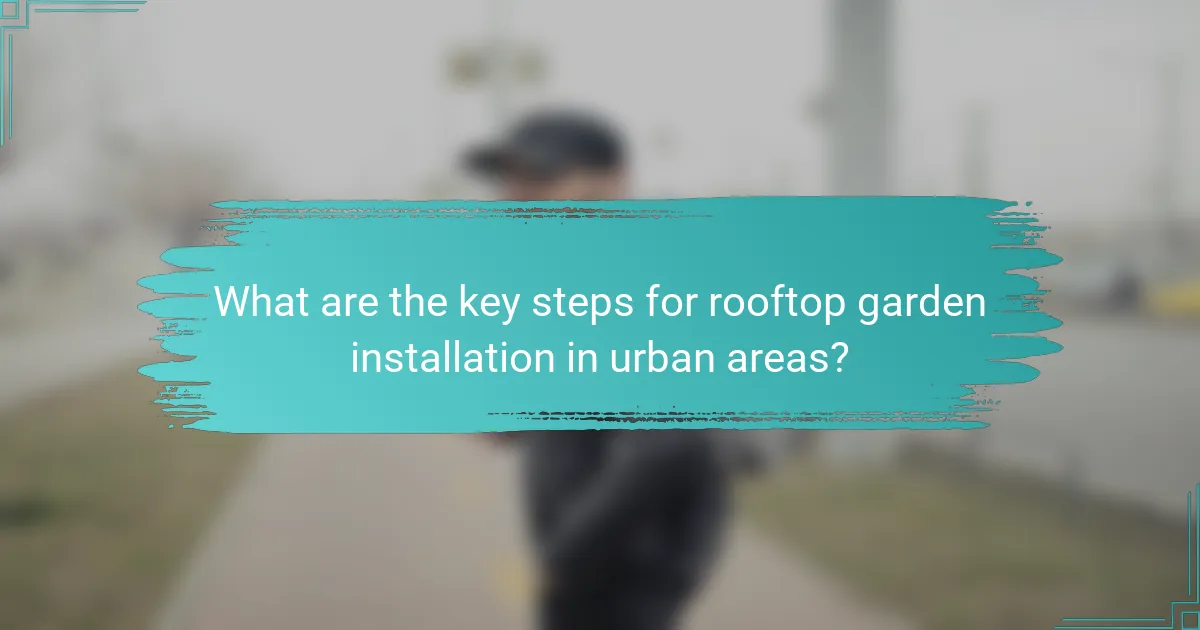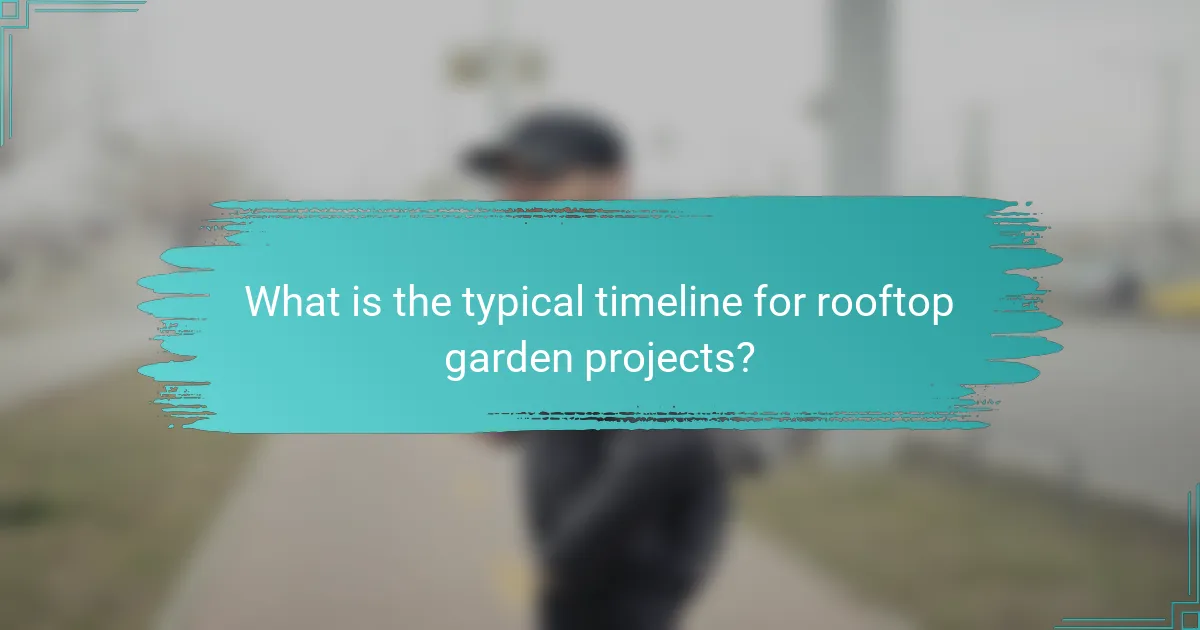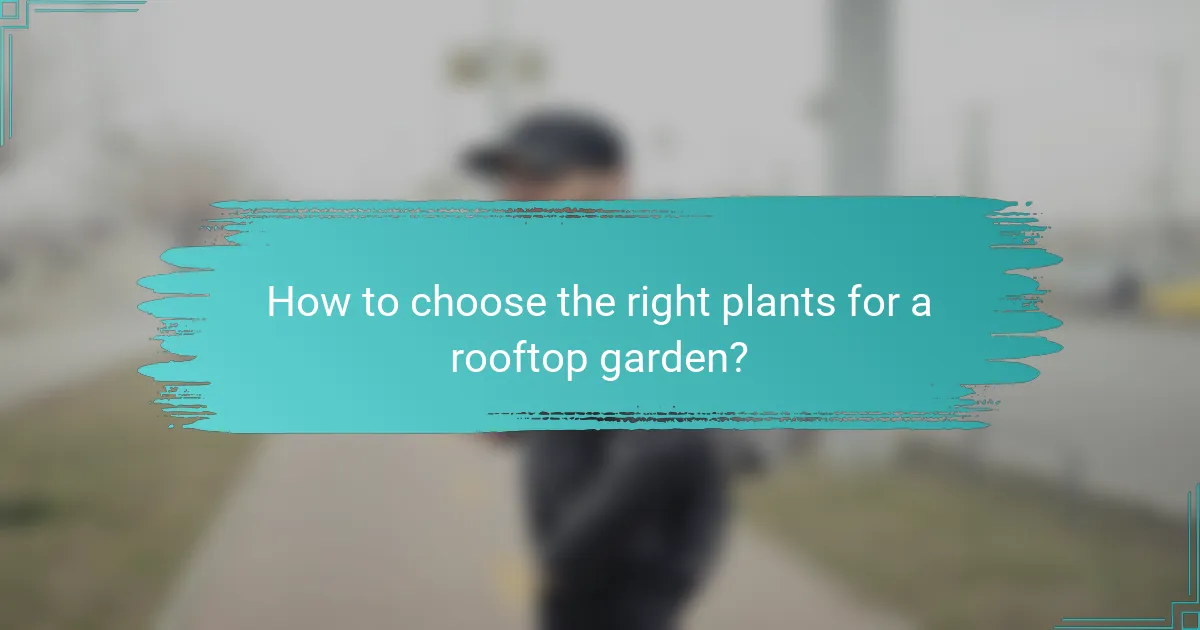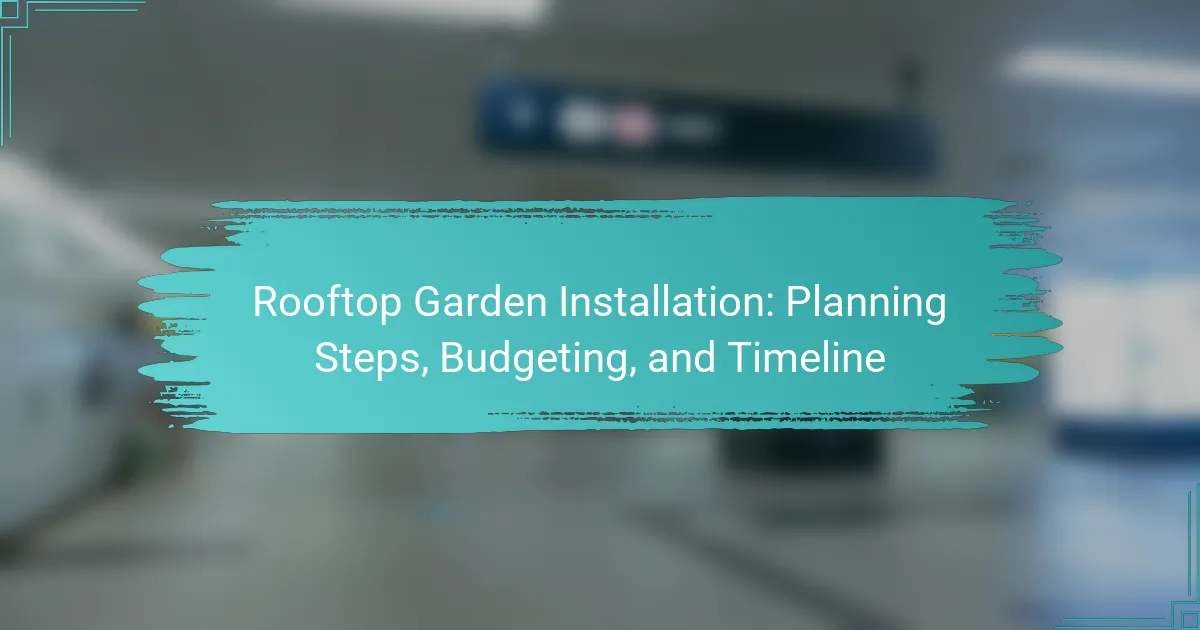Installing a rooftop garden in an urban environment requires careful planning and execution, encompassing site assessment, design, plant selection, and installation. Budgeting is crucial, as it involves accounting for materials, labor, permits, and maintenance to ensure the project’s feasibility. Additionally, the timeline for completion can vary, typically ranging from several weeks to a few months, influenced by the project’s complexity and seasonal factors.

What are the key steps for rooftop garden installation in urban areas?
Rooftop garden installation in urban areas involves several essential steps, including site assessment, design, plant selection, soil management, and the actual installation process. Each step requires careful planning to ensure the garden is functional, sustainable, and compliant with local regulations.
Site assessment and planning
The first step in rooftop garden installation is conducting a thorough site assessment. This includes evaluating the structural integrity of the building, ensuring it can support the added weight of soil, plants, and water.
Consider local zoning laws and building codes, as they may dictate what types of gardens can be installed. Consulting with a structural engineer can provide valuable insights into load-bearing capacities and necessary reinforcements.
Design and layout creation
Once the site is assessed, the next step is to create a design and layout for the rooftop garden. This involves deciding on the garden’s purpose, such as whether it will be ornamental, functional, or a mix of both.
Sketch out the layout, considering factors like sunlight exposure, wind patterns, and accessibility for maintenance. Use design software or consult with landscape architects to visualize the space effectively.
Plant selection and sourcing
Selecting the right plants is crucial for the success of a rooftop garden. Choose species that are well-suited for the local climate and can thrive in containers or raised beds.
Consider native plants, as they typically require less maintenance and are more resilient. Local nurseries or online suppliers can provide a range of options, but ensure they offer healthy, disease-free plants.
Soil and drainage considerations
Proper soil and drainage are vital for rooftop gardens to prevent water accumulation and structural damage. Use lightweight soil mixes designed for container gardening, which often include components like expanded clay or perlite.
Incorporate a reliable drainage system, such as perforated pipes or drainage mats, to direct excess water away from the building. Regularly check the drainage system to avoid blockages that could lead to water pooling.
Installation process
The installation process involves preparing the rooftop, laying down the drainage system, and placing the soil and plants according to the design. Start by ensuring the rooftop surface is clean and free of debris.
Install the drainage system first, followed by the soil layers and plants. Water the plants thoroughly after installation, and establish a maintenance schedule to monitor plant health and irrigation needs.

How to budget for a rooftop garden in New York City?
Budgeting for a rooftop garden in New York City involves understanding the costs associated with materials, labor, permits, and ongoing maintenance. A well-planned budget can help ensure that your garden project is both feasible and sustainable.
Cost of materials
The cost of materials for a rooftop garden can vary widely based on design and plant selection. Basic materials like soil, pots, and plants can start from a few hundred dollars, while premium options such as custom planters or specialized soil can push costs into the low thousands.
Consider sourcing materials locally to reduce shipping costs and support nearby businesses. Additionally, bulk purchasing can often lead to discounts, so it’s worth exploring options with local suppliers.
Labor expenses
Labor expenses for installing a rooftop garden can be significant, especially in New York City where skilled labor rates are high. Hiring a professional landscaper or garden designer may range from $50 to $150 per hour, depending on their experience and the complexity of the project.
For DIY enthusiasts, you can save on labor costs, but be prepared to invest time and effort into the installation. If you choose to hire help, ensure you get multiple quotes to find a competitive rate.
Permitting and legal fees
In New York City, rooftop gardens may require permits, especially if they involve structural changes or significant modifications. Permit fees can range from a few hundred to several thousand dollars, depending on the scope of your project.
Consult with a local architect or contractor familiar with NYC regulations to understand what permits you might need. This can help avoid unexpected fees and ensure compliance with local building codes.
Maintenance costs
Maintenance costs for a rooftop garden can vary based on the types of plants and the level of care required. Monthly maintenance can range from $100 to $500, depending on whether you hire a service or manage it yourself.
Consider factors like irrigation systems, seasonal plant changes, and pest control when budgeting for maintenance. Regular upkeep is essential to keep your rooftop garden thriving and to avoid larger costs down the line.

What is the typical timeline for rooftop garden projects?
The timeline for rooftop garden projects generally spans several weeks to a few months, depending on the project’s complexity and size. Key phases include planning, installation, and seasonal considerations that can impact the overall duration.
Planning phase duration
The planning phase for a rooftop garden typically takes 2 to 6 weeks. This period involves assessing the site, selecting plants, and designing the layout. Engaging with professionals such as landscape architects can streamline this phase but may also extend it due to consultations and revisions.
During planning, it’s crucial to check local regulations and building codes, which can affect timelines. For example, obtaining necessary permits may require additional time, so factor this into your schedule.
Installation time frame
The installation of a rooftop garden usually takes 1 to 3 weeks, depending on the garden’s size and complexity. Simple installations with pre-planted containers can be completed quickly, while more elaborate designs involving soil preparation and structural modifications will take longer.
It’s advisable to schedule installation during favorable weather conditions to avoid delays. Rain or extreme temperatures can hinder progress, so plan for contingencies in your timeline.
Seasonal considerations
Seasonal factors significantly influence the timeline for rooftop garden projects. Spring and early fall are ideal for planting, as temperatures are moderate and rainfall is more consistent. Avoid starting projects in the heat of summer or the cold of winter, as these conditions can stress plants and complicate installation.
Additionally, consider local climate patterns when planning. For instance, in regions with harsh winters, it may be wise to complete the installation before the first frost to ensure plant survival and establish a thriving garden.

What are the prerequisites for rooftop garden installation?
Before installing a rooftop garden, it’s essential to understand the necessary prerequisites, including compliance with building regulations, structural integrity, and proper planning. These factors ensure the safety and success of your garden project.
Building regulations and permits
Building regulations vary by location, but most municipalities require permits for rooftop gardens. These regulations often address structural safety, drainage, and plant selection. Check with your local government or zoning office to determine specific requirements and obtain necessary permits.
Common permits may include zoning approvals, structural modifications, and environmental assessments. Failing to secure the right permits can lead to fines or forced removal of the garden.
Structural assessments
A structural assessment is crucial to ensure that your building can support the weight of a rooftop garden. This evaluation typically involves a professional engineer who will analyze the roof’s load-bearing capacity and recommend any necessary reinforcements.
Consider that a rooftop garden can weigh several hundred kilograms per square meter when fully planted and watered. It’s advisable to conduct this assessment before planning your garden layout to avoid costly modifications later.

How to choose the right plants for a rooftop garden?
Selecting the right plants for a rooftop garden involves considering factors like climate, sunlight exposure, and weight limitations. Prioritize hardy, drought-resistant species that can thrive in containers and withstand wind and temperature fluctuations.
Consider climate and sunlight
Your rooftop garden’s success largely depends on the local climate and the amount of sunlight it receives. Assess whether your area has a hot, dry climate or a cooler, wetter one, and choose plants that are well-suited to these conditions. For sunny rooftops, consider sun-loving plants like succulents and herbs, while shaded areas may benefit from ferns and shade-tolerant flowers.
Assess weight limits
Before planting, check the structural weight limits of your rooftop. Soil, plants, and containers can add significant weight, so opt for lightweight potting mixes and choose smaller plants to avoid overloading the structure. A general guideline is to keep the total weight under 100 kg per square meter, but consult a structural engineer for specific recommendations.
Choose appropriate containers
Containers play a crucial role in a rooftop garden’s design and plant health. Select pots that provide adequate drainage and are made from materials that can withstand outdoor conditions, such as ceramic, fiberglass, or treated wood. Ensure that containers are deep enough to accommodate root systems, typically at least 30 cm for most plants.
Plan for maintenance
Consider the maintenance needs of your chosen plants. Some species require regular watering and pruning, while others are more low-maintenance. Incorporate a mix of plants to create visual interest while balancing the care required. For instance, pairing drought-tolerant succulents with vibrant annuals can provide color without excessive upkeep.
